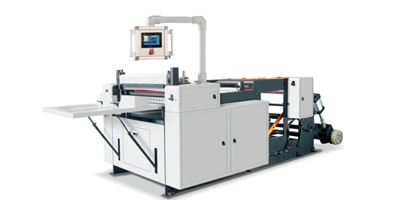The production speed of a roll - to - sheet cutting machine is a critical aspect that significantly impacts the efficiency and productivity of industries relying on paper, film, or other roll - based material processing. This speed is not a fixed value and is influenced by multiple interrelated factors.

Machine Design and Technology
The fundamental design of the roll - to - sheet cutting machine plays a pivotal role in determining its production speed. Modern high - end machines are engineered with advanced drive systems. For example, those equipped with servo - motor - driven systems can achieve rapid and precise movements. Servo motors offer excellent control over acceleration and deceleration, enabling the machine to start and stop the cutting process quickly between each cut. In contrast, older - style machines with basic mechanical drives may have limitations in speed due to slower response times and higher inertia.
The cutting mechanism also affects speed. Rotary cutting systems, which use circular blades rotating at high speeds, are generally faster than guillotine - style cutters. Rotary cutters can continuously cut the material as it moves, without the need for the stop - start motion characteristic of guillotine cutters. Additionally, the quality of bearings and guides in the machine is crucial. High - quality, low - friction bearings and precision guides allow for smooth movement of the cutting components, reducing energy losses and enabling higher speeds.
Material Characteristics
The type of material being cut has a substantial impact on the production speed. Thinner and more flexible materials, such as lightweight tissue paper or thin plastic films, can be processed at higher speeds. These materials require less force to cut and can be easily fed through the machine. For instance, a HKA-L Roll To Sheet Paper Cross Cutting Machine can cut tissue paper at a much faster rate compared to thicker cardboard.
On the other hand, thicker, more rigid materials like heavy - duty cardboard or certain types of industrial fabrics pose challenges. They require more powerful cutting forces, which may limit the machine's speed. Moreover, materials with irregular textures or those that tend to fray easily may need slower cutting speeds to ensure clean and accurate cuts. For example, cutting a rough - textured, fiber - rich material at high speed may result in jagged edges or uneven cuts.
Cutting Parameters and Settings
The specific cutting parameters set on the machine also determine its production speed. The cutting length is a key factor. Shorter cutting lengths generally allow for higher production speeds as the machine has to travel a shorter distance for each cut. However, if the cutting length is set too short, it may increase the frequency of the cutting action, potentially leading to overheating of the cutting blades or excessive wear on the machine components.
The cutting frequency, which is related to how often the cutting mechanism operates, also affects speed. Some machines are designed to operate at a fixed cutting frequency, while others allow for adjustment. Increasing the cutting frequency can boost production speed, but it must be balanced with the machine's mechanical capabilities and the material being processed. For example, if the cutting frequency is set too high for a thick material, the machine may struggle to cut cleanly, and the blades may wear out rapidly.
Operator Skills and Machine Maintenance
The proficiency of the operator can influence the production speed. A well - trained operator who is familiar with the machine's controls and capabilities can optimize the production process. They can quickly set up the machine for different materials and cutting requirements, reducing downtime between production runs. Additionally, an operator who can identify and address minor issues promptly, such as a misaligned roll or a slightly dull blade, can keep the machine running smoothly at its optimal speed.
Regular and proper machine maintenance is equally important. A well - maintained machine is more likely to operate at its maximum speed. This includes tasks such as lubricating moving parts, sharpening or replacing cutting blades when they become dull, and ensuring that all sensors and control systems are functioning correctly. Neglecting maintenance can lead to mechanical failures, reduced cutting accuracy, and ultimately, a decrease in production speed.
In conclusion, the production speed of a roll - to - sheet cutting machine is a complex function of machine design, material characteristics, cutting parameters, operator skills, and maintenance. By understanding and optimizing these factors, industries can maximize the productivity of their roll - to - sheet cutting operations.

GET A QUOTE